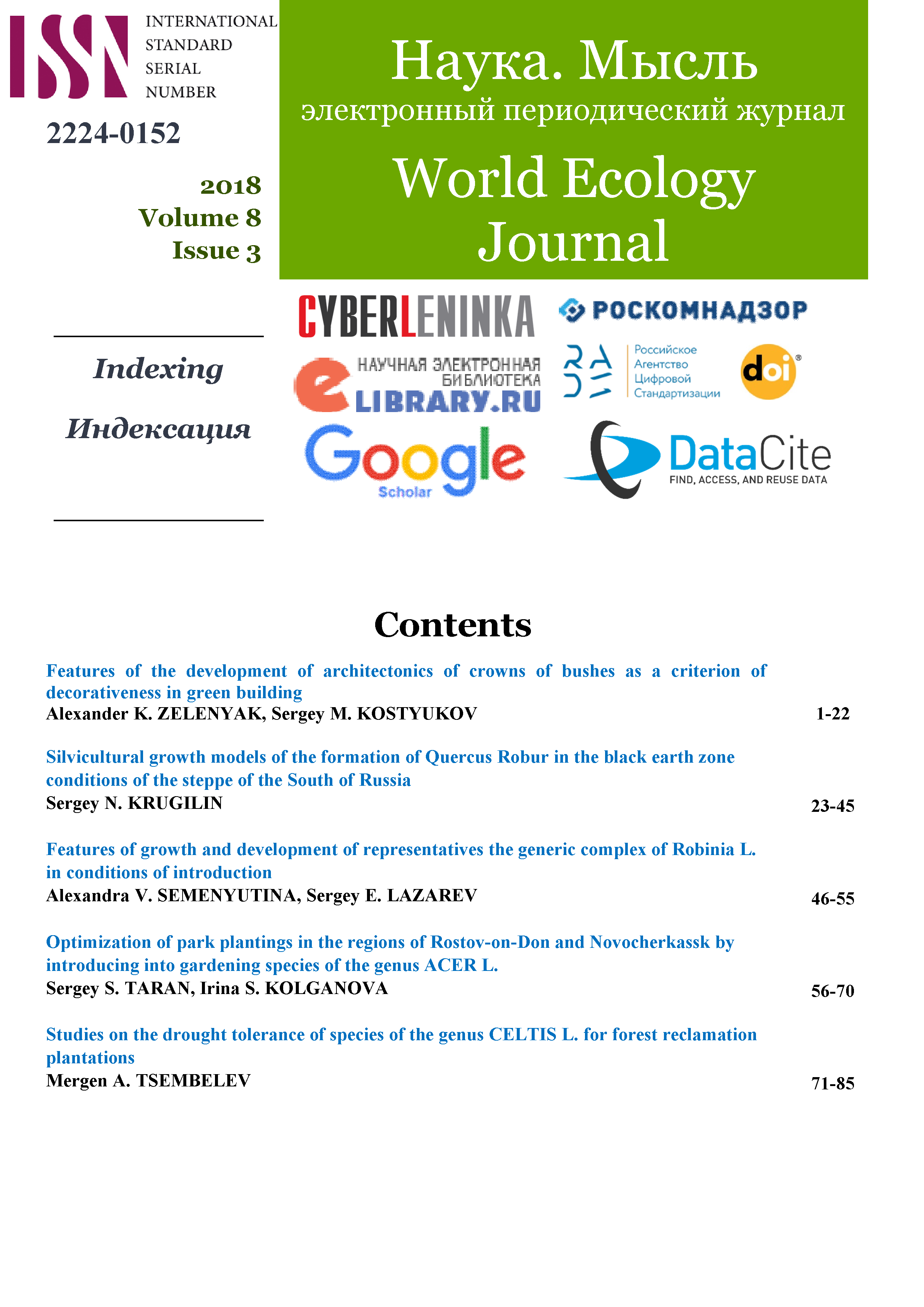Studies on the drought tolerance of species of the genus CELTIS L. for forest reclamation plantations
DOI:
https://doi.org/10.25726/NM.2019.44.92.005Keywords:
Drought resistance, water regime, chestnut soils, Celtis L. (frame), colloid-osmotic properties of protoplasm, Lower Volga regionAbstract
The limiting factors of the functioning of forest melioration plantations in the Lower Volga region are moisture deficiency during the growing season, high and low temperatures, and also limit the area of sustainable plant culture. The search for new tree species for forest melioration plantations in the Lower Volga region remains highly relevant, especially in relation to dry conditions (+ 42 ° C, minimum air humidity within 16-25%, reduction of moisture in 2 mm soil layer to 150 mm). From the family of skeletons (Celtidaceae Link), the generic complex - skeleton (Celtis L.) is of interest.
The purpose of the research is to identify drought-resistant species of the genus Celtis L. using a set of ecological and physiological parameters for use in forest melioration plantings in the Lower Volga region.
The objects of research were 7 species of the clan complex Celtis L. (C. bungeana Blume., C. occidentalis L., C. caucasica Willd., C. pumila Pursh, C. reticulata Torr., C. crassifolia Lam., C. australis L .), of various geographical origin, which grow in the collections of the Federal Science Center of Agroecology RAS (Volgograd, Kamyshin).
It was revealed that a low water deficit (up to 20%) is observed in the species Celtis L. (C. occidentalis L., C. reticulata Torr., C. crassifolia Lam., C. australis L. and C. bungeana Blume.).
The studied species of Celtis L. were divided into the first (relative yield of electrolytes - 1.41-1.69) and the second (2.08-2.41) groups according to the degree of drought tolerance.
In Celtis L. species, they adapt with age at the morphophysiological level, which contributes to the expansion of the tolerance limits of the species to unfavorable environmental conditions. For forest reclamation plantations on forest soils of the region (all subtypes of chestnut soils) are recommended Celtis occidentalis, C. crassifolia, C. reticulata, C. australis, C. bungeana (drought-resistant species of the first group).
Our studies on the drought tolerance of species of the genus Celtis L. indicate the prospects for selecting plants for forest melioration plantings using the following experimental criteria: water content, water holding capacity, water deficit, relative electrolyte yield.
References
2. Workshop on growth and plant resistance: studies. allowance V. V. Polevoy et al. SPb .: S.-Peter. Univ., 2001. 212 p.
3. Ryndin A.V., Belous O.G., Malyarovskaya V.I., Pritula Z.V., Abilfazova Yu.S., Kozhevnikova A.M. The use of physiological and biochemical methods to identify the adaptation mechanisms of subtropical, southern fruit and ornamental crops in the conditions of subtropics of Russia. Agricultural biology. 2014. №3. Pp. 40-48.
4. Sapanov M.K. Ecology of forest plantations in arid regions. Tula: Grif and Co., 2003. 248 p.
5. Svintsov I.P., Semenyutina V.A. Methodological basis for the study of plant organisms in the introduction of modern science: current problems of theory and practice. A series of natural and technical sciences. No. 9-10. 2014. pp. 42-47.
6. Semenyutina A.V., Kostyukov S.M., Kashchenko E.V. Methods for identifying the adaptation mechanisms of tree species in connection with their introduction to arid regions. Advances in modern science. 2016. №2. Pp. 103-109.
7. Semenyutina A.V., Petrov V.I., Podkovyrov I.Yu. Methods for determining the prospects of introduction of Ulmus L. and Celtis L. species for protective afforestation and gardening. Modern science: current problems of theory and practice. A series of natural and technical sciences. 2015. № 7-8. Pp. 56-69.
8. Semenyutina A.V., Khuzhakhmetova A.Sh., Podkovyrov I.Yu., Svintsov I.P. The scientific basis of introduction by the method of generic complexes with the aim of selecting woody species for green technologies. Fundamental research. 2015. № 2 (part 21). Pp. 4687-4692.
9. Tsembelev MA Perspectives of introduction of generic complexes of woody species for protective afforestation and gardening. Problems of nature conservation of landscapes: Intern. scientific-practical conf. April 24-25, 2014 Part 2. Novocherkassk: Lik, 2014. P. 162-168.
10. Podkovyrov I.Y., Tsembelev M.A. Criteria Occupation Perspectives for Generic Ecosystems: Mater. V mizhnar. sciences. conf. (m. Donetsk, 12-15 grass 2014 p.). Donetsk, 2014. p. 262-264.
11. Ma, F. Effects of greenhouse grown pear-jujube tree. F. Ma, S. Kang, F. Li, J. Zhang, T. Du, X. Hu Agricultural Agricultural Water Management. 2007. 90 (3). R. 190-196.
12. Larcher W. Okologie der Pflanzen. Stuttgart, 1976. 320 s.
13. Rehder A. Trees and Shrubs for Hardies in North America A. Rehder. N.Y., 1949. 1996 p.
14. Semenyutina A.V., Podkovyrov I.Y., Huzhahmetova A.Sh., Semenyutina V.A., Podkovyrova G.V. The International Journal of Pure and Applied Mathematics. 2016. - Volume 110. №2. p. 361-36




